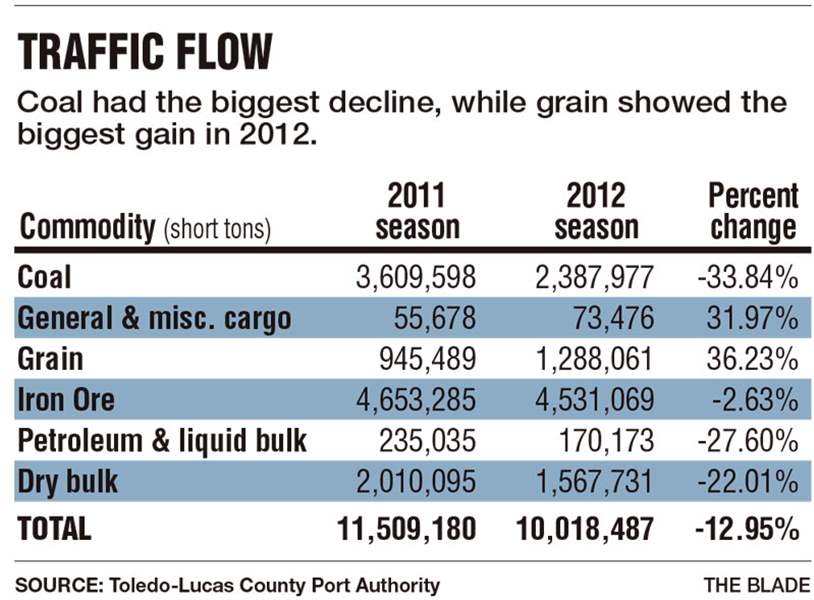
Toledo port records 13% decline in cargo
Warm winter in ’12 adds to shipping woes
1/21/2013

Record-low coal business and a steep drop in salt shipments after a warm winter were the main factors in a nearly 13 percent decline in cargo traffic through the Port of Toledo during 2012, the Toledo-Lucas County Port Authority’s year-end statistics show.
Ships loaded or unloaded 10,018,487 tons of cargo in Toledo last year, down 12.95 percent from the 11,509,180 tons that crossed the local docks in 2011, according to the port authority.
Coal led the decline, dropping from 3,609,598 tons to 2,387,977 tons — the lowest volume since the 1947 start of Toledo port records now kept by the port authority. Toledo’s numerous coal docks handled more than 23 million tons in 1947; the previous record low was the 2.74 million tons through the port in 2004.
The biggest drop involved domestic coal shipments, which fell from 2,055,614 tons to 1,033,235 tons. Domestic coal shipments from Toledo primarily go to power plants, and utility-coal consumption lagged in 2012 as electric firms shifted power generation to plants burning cheaper natural gas and announced coal-plant closings they blamed on stricter pollution regulations.
Shipments to Canada, Toledo’s other primary coal market, fell by a relatively modest 15.5 percent, but Joe Cappel, the port authority’s director of cargo development, said electric utilities there also face clean-air mandates that are taking coal plants off line.
“We ship a lot of coal to Canada, and we’re not alone in that,” Mr. Cappel said.
CSX Transportation, which runs the port-owned coal dock under a long-term lease, “assure[s] me that they’re seeking out new customers,” including overseas, to make up for some of the lost business, he said.
Dry-bulk commodities, the category that includes salt, had the other big tonnage decline, falling by more than 440,000 tons or 22 percent. Salt from mines in the United States and Canada that is shipped into Toledo primarily for winter ice control accounted for more than half that drop.
“With such a mild winter, we didn’t really need to resupply,” Mr. Cappel said.

Iron ore, which last year surpassed coal as the Toledo port’s biggest cargo by weight, fell by about 128,000 tons, or 2.63 percent, while the petroleum and liquid bulk sector was down by about 65,000 tons, a 27.6 percent decline.
Grain business, which rose by more than 340,000 tons despite a drought-impaired harvest, and general cargo traffic were the local port’s bright spots in 2012.
Jim McKinstray, vice president of central merchandising and transportation for The Andersons, credited the improvement mainly to a strong export market for soybeans, which were in high demand late last year.
“The crops were a little better than the worst fears [from the drought], especially north of I-80 and in soybeans,” he said.
Furthermore, he said, increasing soybean cultivation in Brazil, where the harvest occurs in February and March, is reducing spring futures prices for American beans, so better fall prices provide an incentive to move beans then.
Mr. Cappel said import shipments of oats also contributed to the grain increase, while “really strong” aluminum imports helped the general-cargo sector. While the smallest part of the port’s business by weight, general cargo generates the highest per-ton revenue for the port authority and is more labor-intensive.
The cargo-development director said efforts continue by the port authority and Midwest Terminals of Toledo, the general cargo dock operator, to identify new markets for Toledo’s port. “If some of these traditional cargoes are being replaced by other commodities, what other commodities can we pursue?” he said.
The Lake Carriers Association reported Friday that the 57-vessel U.S.-flag Great Lakes fleet carried 89.5 million tons of cargo during 2012, down 4.6 percent from 2011’s float and 1.5 percent below the five-year average. The American fleet carries primarily iron ore, limestone, and coal, along with smaller volumes of other domestic bulk cargoes.
At least some of Toledo’s iron-ore traffic could be endangered two years from now, when a planned iron-processing plant in northwest Indiana is slated to open.
Magnetation LLC plans to process iron concentrate reclaimed from tailings piles at northern Minnesota iron mines into iron-ore pellets at the $300 million plant in Reynolds, Ind., for which a groundbreaking is planned by March. AK Steel, which owns 49.9 percent of Magnetation LLC, expects the plant’s production to satisfy half of its iron-ore needs.
AK Steel’s mills in Middletown, Ohio, and Ashland, Ky., are the primary destinations for iron ore shipped through the Port of Toledo. An AK spokesman declined to say, however, what percentage of that firm’s iron ore uses the Toledo port.
Mr. Cappel said it would be speculative to discuss how the Magnetation project will affect Toledo.
“We don’t really know what percentage could be taken away,” Mr. Cappel said. “Or maybe they [AK Steel] plan on growing, and it won’t change at all.”
Contact David Patch at: dpatch@theblade.com or 419-724-6094.